

Inviting wild birds to forage for snacks in hedges is one of the most thrilling garden shows – and it’s great for the environment, too.
Miles of hedges along fields disappeared from our countryside when machines took over farming.
These hedges used to be a home for birds and source of food. Today, decades later, the consequences are getting back at us: with less helpful birds around, pests and insects become uncontrollable.
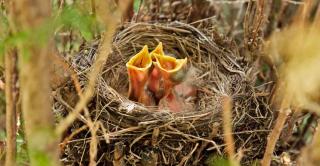 Also, hedges that produce berries attract a great many insects when they bloom: this is also a new source of food for birds.
Also, hedges that produce berries attract a great many insects when they bloom: this is also a new source of food for birds.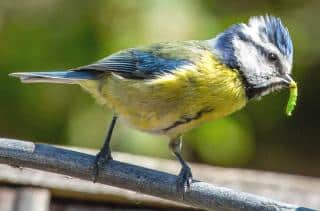 Birds, even though some are considered pests by some gardeners, are generally excellent insect pest control. A single song thrush can eat up to 10,000 larvae (caterpillars, codling moths), flies, snails and more just during the mating and reproduction season.
Birds, even though some are considered pests by some gardeners, are generally excellent insect pest control. A single song thrush can eat up to 10,000 larvae (caterpillars, codling moths), flies, snails and more just during the mating and reproduction season.The goal of such hedges is to have as much diversity as can be, so that food is available over a long span of time, ideally ranging from August to the beginning of March. Some berries are known to attract specific bird species:
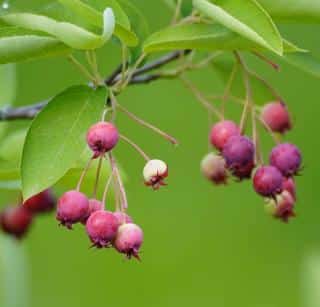 amelanchier attracts robins, whitethroats, bullfinches and starlings;
amelanchier attracts robins, whitethroats, bullfinches and starlings;This illustrates how important it is to have different types of shrubs. As should be when planting anything, check that the species you select are compatible with your soil type: for instance, blueberry must have acidic soil. Luckily, most available hedge shrubs can make do with any kind of soil, except perhaps those areas where chalk and lime is particularly active.
Ideally, you’d let the hedge grow wild, pairing tree-like shrubs with shorter, bushy ones: this will give birds different levels of shrubbery to roost and nest in. In a city, you won’t have as many option: best find a few compact, short-growing species or control growth with regular pruning.
Remember to keep a strip of wild grasses along the base, this hinders predators.
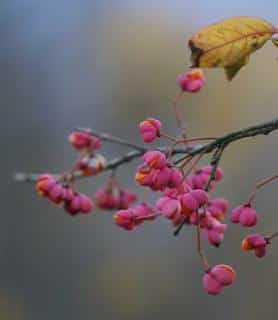 This native-to-Europe species does well even in chalky soil. Its “bishop’s hat”-like fruits open into four bright coral-colored quarters, revealing orange seeds hidden inside.
This native-to-Europe species does well even in chalky soil. Its “bishop’s hat”-like fruits open into four bright coral-colored quarters, revealing orange seeds hidden inside.
E. alatus ‘Compactus’ is a shorter, stouter variety, (3 feet tall by 5 feet across) that has knobby growth along the branches. Its carmine red fall colors are truly spectacular.
Spindle is where bullfinches, black-capped chickadees and long-tailed tits set up shop.
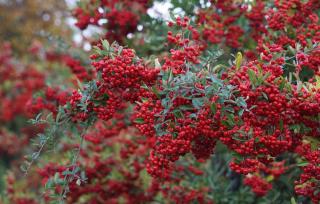 Pyracantha stands out thanks to its dense, shiny foliage and cream-colored blooming in April-May. Bees love foraging for pollen, and birds love the red, orange or yellow berries that appear over summer.
Pyracantha stands out thanks to its dense, shiny foliage and cream-colored blooming in April-May. Bees love foraging for pollen, and birds love the red, orange or yellow berries that appear over summer.
Birds get to feast on them during the entire winter. It does have a defensive role against intruders, thanks to its thorns (like barberry). Just train it along the side of the house to great heights, over 12 feet or 4 meters high.
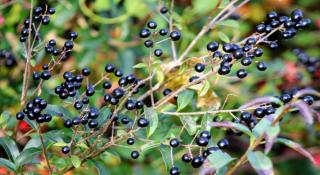 This small evergreen tree produces clusters of creamy-white flowers in May-June, replaced in time by just as many black berries that tits, hawfinches and greenfinches adore…
This small evergreen tree produces clusters of creamy-white flowers in May-June, replaced in time by just as many black berries that tits, hawfinches and greenfinches adore…
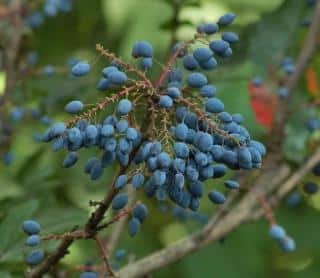 Ideal for shaded areas under trees, or wedged between other shrubs in a hedge for a bright, fragrant blooming during winter, Mahonia also does well as a standalone thanks to its shiny, holly-like leaves.
Ideal for shaded areas under trees, or wedged between other shrubs in a hedge for a bright, fragrant blooming during winter, Mahonia also does well as a standalone thanks to its shiny, holly-like leaves.
Its blue-gray berries (which are delicious in jam for us) are a favorite of birds.
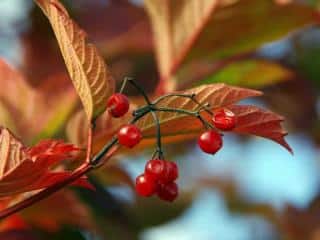 This European shrub unveils flat, white flower clusters in May-June. The three-lobed leaves take on beautiful hues in fall, and at the same time deep red clusters of berries appear (not edible). It appreciates cool soil.
This European shrub unveils flat, white flower clusters in May-June. The three-lobed leaves take on beautiful hues in fall, and at the same time deep red clusters of berries appear (not edible). It appreciates cool soil.
Ah, one thing to know: the famous ‘Roseum’ cultivar won’t produce berries!
Callicarpa, ivy, Skimmia, Cotoneaster, snowberry, elder, rowan, holly, hawthorn…
To learn more, read: